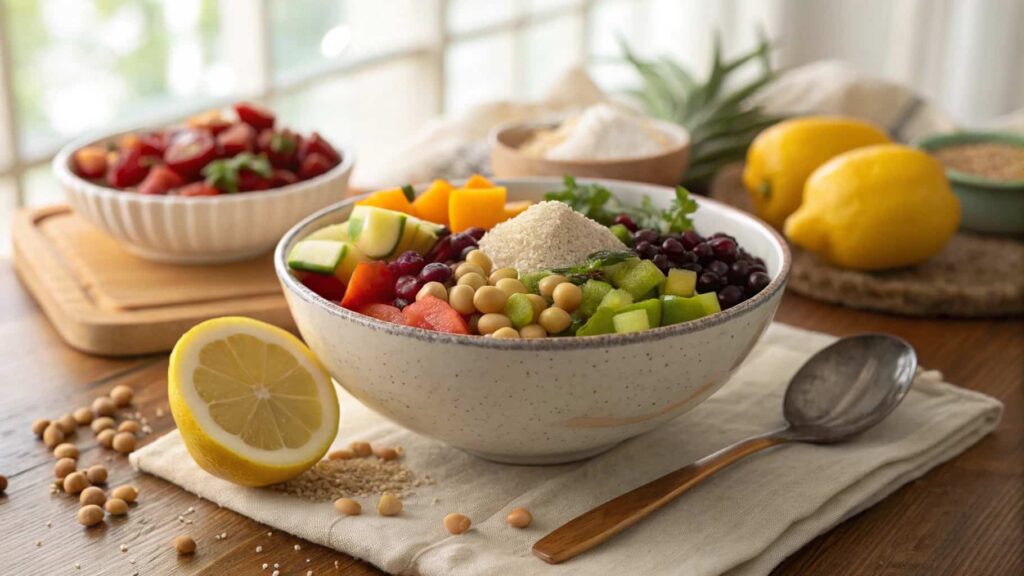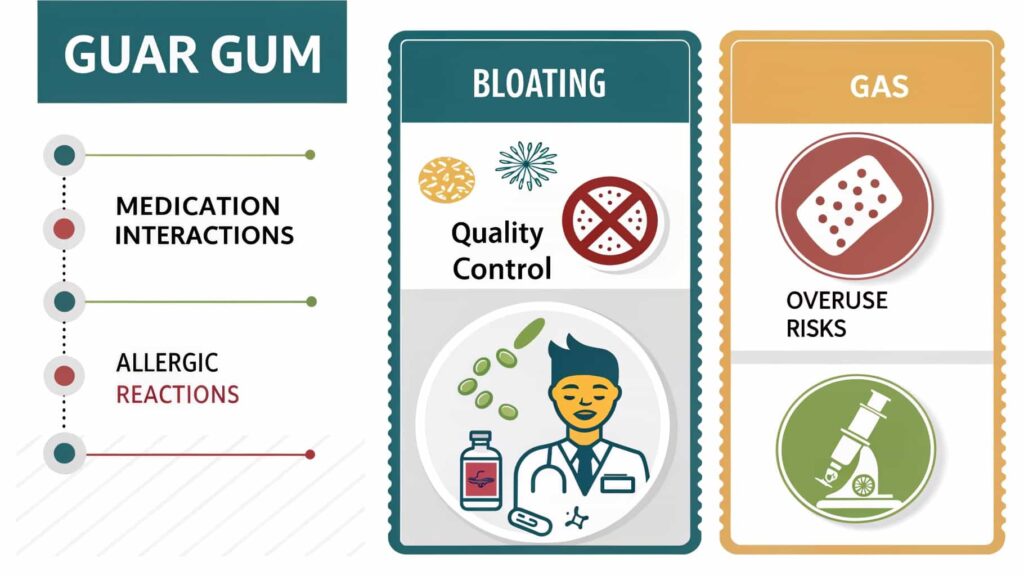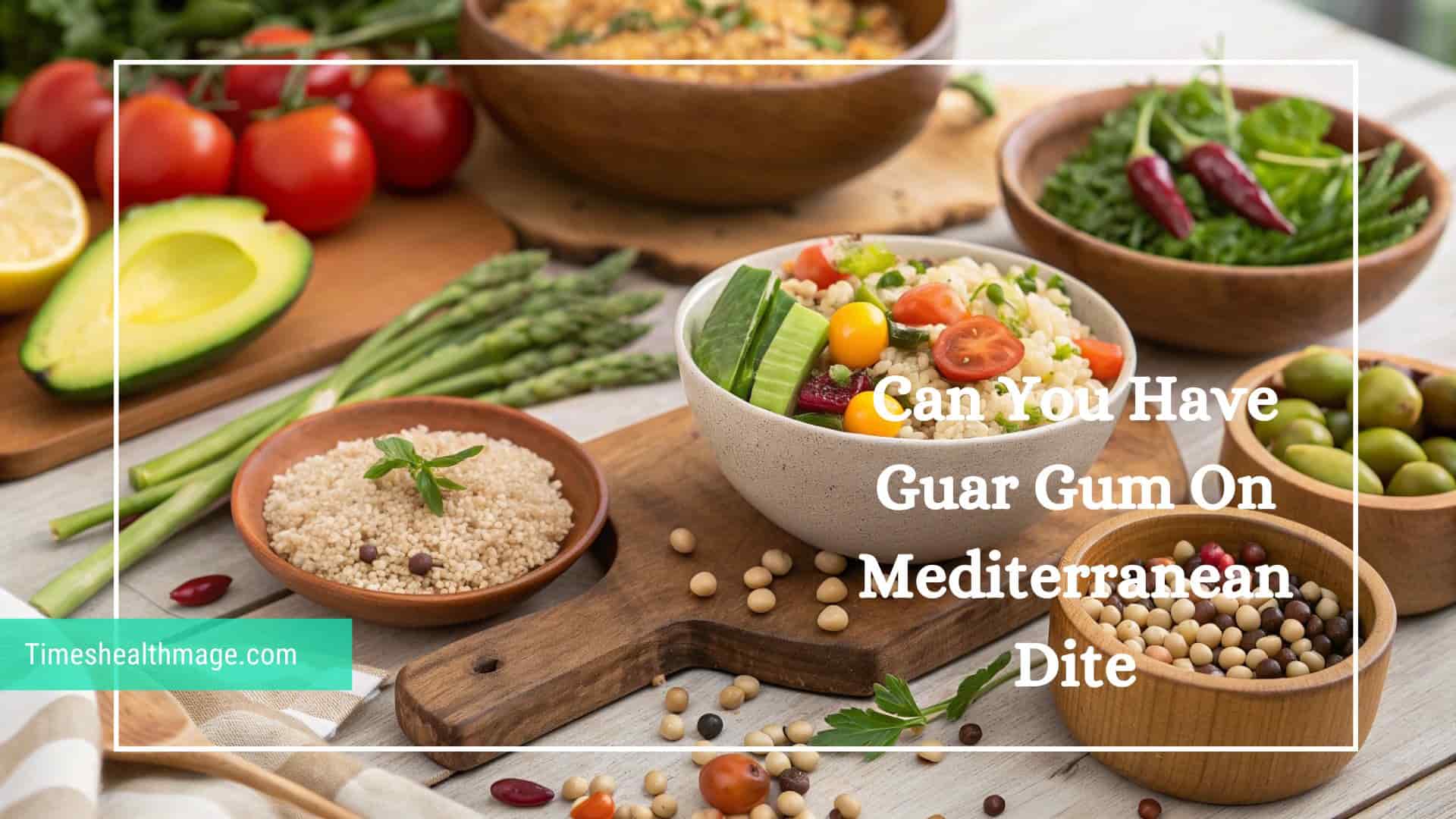Modern diets are continuously evolving to incorporate new ingredients, improve health outcomes, and meet individual preferences. One topic that sparks curiosity for many health enthusiasts is whether guar gum fits into certain eating styles—especially those focused on whole, natural foods, like the Mediterranean diet. While the Mediterranean diet tends to emphasize fresh produce, legumes, whole grains, and healthy fats, there’s often uncertainty about newer or lesser-known additives.
This article answers the central question: Can you have guar gum on the Mediterranean diet? We’ll dive into everything from the basics of guar gum to its health benefits, potential drawbacks, tips for use, and how it aligns with the tenets of Mediterranean-style eating. By the end, you’ll have a clear understanding of whether this soluble fiber can comfortably find its place in your kitchen cupboard, without compromising the vibrant and wholesome spirit of the Mediterranean diet.
The Mediterranean Diet -Why It’s the Best Choice For Your Health!
Before we tackle guar gum specifically, it helps to recall what makes the Mediterranean diet so popular and enduring. The eating patterns of many countries along the Mediterranean Sea—such as Greece, Italy, Spain, and parts of France—have attracted scientific interest for decades due to consistently lower rates of cardiovascular diseases in those populations.

Key Pillars of the Mediterranean Diet:
- Emphasis on Plant-Based Foods: Fruits, vegetables, whole grains, beans, legumes, nuts, and seeds form the foundation of most meals. These staples supply ample vitamins, minerals, fiber, and antioxidants.
- Healthy Fats: Olive oil takes center stage as the primary source of dietary fat. Small portions of cheese, yogurt, and other dairy items also play a role, but they typically come from sheep or goat’s milk.
- Lean Protein Sources: Fish and seafood are eaten a few times per week, while poultry and eggs are consumed in moderation. Red meat appears less frequently on the menu and is usually portion-controlled.
- Flavorful Seasonings: Herbs, spices, lemon juice, and occasionally red wine are used to season dishes, reducing the reliance on salt and unhealthy fats.
- Lifestyle Factors: Social interaction, leisurely dining, and regular physical activity are also viewed as part of the Mediterranean approach. Overall, it’s not just a diet plan but an entire way of living.
The Mediterranean diet is part of a broader movement toward more mindful and health-conscious living. To support this, you may also want to explore natural remedies for additional wellness benefits.
What Is Guar Gum?
Guar gum is a plant-based polysaccharide extracted from the seeds of the guar bean (Cyamopsis tetragonoloba), a legume predominantly Guar gum originates from the guar bean (Cyamopsis tetragonoloba), a legume typically cultivated in India and surrounding regions. When guar beans are harvested, their seeds are processed, dehusked, and ground into a fine powder known as guar gum. This powder is widely used in the food industry because it can thicken, stabilize, or bind ingredients together.
Common Uses of Guar Gum
- Thickening Agent in soups, sauces, and salad dressings
- Stabilizer in dairy products like yogurt or ice cream
- Emulsifier to help oil and water-based ingredients blend smoothly
- Gluten-Free Baking Aid to improve texture and moisture retention
Since guar gum is derived from a legume, it is technically a plant-based product—this point alone can reassure those who follow diets that prioritize plant sources.
Is Guar Gum Considered Natural or Processed?
One question that often arises is whether guar gum should be seen as too “processed” for a diet that celebrates whole foods and home-style cooking. The answer is nuanced:
- Natural Origin: Guar gum starts out as a legume, which aligns with plant-based principles.
- Processing: To become a powder, guar beans undergo milling and certain refining steps. While this is undoubtedly a form of processing, it’s not necessarily in the realm of ultra-processed chemicals or additives that are purely synthetic.
The Mediterranean diet does not strictly forbid all forms of processing; rather, it emphasizes moderate, sensible use of ingredients with a strong preference for minimally processed foods. Guar gum, in modest amounts, generally falls within these acceptable boundaries—particularly when chosen carefully from reliable food-grade sources.
What Is The Nutritional Profile Of Guar Gum?
Guar gum is primarily made up of soluble fiber, which makes it highly beneficial for digestion and overall gut health. It contains very few calories because it’s used in small amounts, and it has no significant amounts of fat, protein, or sugar. The soluble fiber in guar gum absorbs water and forms a gel-like substance, which can help improve bowel regularity and support heart health by lowering LDL cholesterol.
While it doesn’t provide many micronutrients, its fiber content offers digestive and metabolic benefits. Its neutral taste and texture make it easy to use in various recipes without altering the overall flavor. However, because it’s typically used in small amounts, its direct nutritional contribution to a diet is modest, but it still plays a supportive role in overall health.
Potential Health Benefits Of Guar Gum – How It Can Improve Your Health!
For anyone wondering, “Can you have guar gum on Mediterranean diet?” the answer often hinges on whether guar gum adds or detracts from the diet’s healthful aims. Let’s explore the potential benefits:

Digestive Support:
Thanks to its soluble fiber, guar gum may act as a prebiotic, fostering the growth of beneficial gut bacteria. A healthier gut microbiome is linked to improved digestion, better nutrient absorption, and reduced inflammation. If you’re already eating Mediterranean staples—like fruits, vegetables, and legumes—adding a small amount of guar gum could further support gut health.
- How It Works: When soluble fiber dissolves in water, it forms a gel-like substance that can influence the speed at which foods travel through the digestive tract, as well as how nutrients are absorbed.
Cholesterol and Blood Sugar Control:
The gel formed by soluble fibers like guar gum can bind to bile acids and certain lipids, helping reduce LDL (“bad”) cholesterol. By slowing carbohydrate absorption, guar gum may also promote steadier blood sugar levels. These effects can be highly compatible with the Mediterranean diet’s reputation for heart health and metabolic balance.
Balancing Fats and Sugars
- Healthy Fats: The Mediterranean diet includes plenty of extra-virgin olive oil, nuts, and seeds, all beneficial for cholesterol. Guar gum can complement these.
- Blood Sugar Stability: Legumes and whole grains in the Mediterranean diet already provide a slow-release source of carbs. Guar gum may further assist in evening out post-meal glucose spikes.
Weight Management:
While not a weight-loss cure-all, guar gum’s capacity to increase satiety could be one tool among many for maintaining a healthy weight. When combined with a naturally balanced diet rich in vegetables, fruits, and lean proteins, a slightly greater feeling of fullness from guar gum may help curb overeating.
Potential Anti-Inflammatory Effects:
Studies suggest that soluble fibers can nurture beneficial microbes in the gut that reduce low-grade inflammation. Chronic inflammation is often associated with metabolic disorders, heart disease, and more. Adding guar gum to an already inflammation-fighting regimen like the Mediterranean diet—rich in antioxidants and healthy fats—could offer an extra edge.
Safety Considerations And Potential Drawbacks – Is It Safe For You?
While guar gum can be beneficial, it’s important to acknowledge potential side effects and usage guidelines:
- Gastrointestinal Discomfort: Some individuals may experience bloating, gas, or even diarrhea if they consume guar gum in excess. Generally, this risk is minimized if you use small, recipe-appropriate amounts rather than taking high-dose supplements.
- Medication Interactions: In some cases, guar gum can interfere with the absorption of certain medications, particularly those taken for blood sugar management (e.g., metformin). If you’re on prescription drugs, consider consulting a healthcare provider before significantly increasing guar gum in your diet.
- Contamination Risks: Although rare with reputable brands, there have been historical instances of non-food-grade guar gum containing contaminants like dioxins. Always purchase food-grade guar gum from trusted sources to ensure safety and purity.
- Texture Overload: Adding too much guar gum can backfire. It might create a slimy or overly dense texture that distracts from the fresh flavors central to Mediterranean cooking.
Using Guar Gum In A Mediterranean Diet Kitchen – Dont Miss Out!
If you decide to embrace guar gum in your Mediterranean meal planning, how exactly can you use it? Below are practical applications that stay true to the diet’s focus on fresh, vibrant foods:
- Salad Dressings: Combine olive oil, vinegar or lemon juice, herbs, and a small pinch of guar gum to create a smoother, more stable emulsion. The guar gum prevents separation without the need for heavy cream or other thickening agents.
- Soups and Stews: Traditional Mediterranean soups often rely on beans, lentils, and vegetables for thickness. However, if you prefer a silkier texture, a scant amount of guar gum whisked in can help achieve that result without heavy dairy or flour roux.
- Smoothies and Beverages: Although smoothies aren’t always a traditional Mediterranean component, they are popular in many modern adaptations. A touch of guar gum can give your smoothie a creamy mouthfeel, even if you rely on Greek yogurt, fruits, and greens as your main ingredients.
- Sauces for Fish or Poultry: Mediterranean diets include moderate amounts of lean proteins like fish and chicken. If you’re making a light sauce with tomatoes, onions, and herbs, a small bit of guar gum can thicken it to a restaurant-quality consistency.
Helpful Tip: Always dissolve guar gum in water or another liquid before adding it to your recipes. This ensures even distribution and minimizes any lumps. Alternatively, you can mix guar gum with dry ingredients first. Small amounts—often as little as 1/2 teaspoon for an entire dish—are typically sufficient. Physical activity is a key part of the Mediterranean lifestyle, so knowing how to recover faster from strain can be crucial when you’re active and experimenting with new foods like guar gum.
Guar Gum In The Mediterranean – Is It A Good Choice?
Because the Mediterranean diet is known for its wide array of vegetables, fruits, grains, and legumes, the addition of guar gum isn’t out of place. From a cultural standpoint, guar beans themselves aren’t traditionally Mediterranean. However, the region has long embraced trade and new culinary techniques. Many contemporary Mediterranean cookbooks and restaurants do incorporate novel thickeners to improve mouthfeel or accommodate dietary restrictions (such as gluten intolerance).
Balancing Tradition and Innovation:
While tradition is a large part of the Mediterranean ethos, the spirit of the diet also lies in freshness, healthfulness, and enjoyment. If guar gum helps you create nutritious meals that you and your family love, then it’s likely a beneficial addition.
Addressing Concerns About Processed Foods – Key Facts!
It’s natural to question whether something as specialized as guar gum would undermine the “whole-food” lens of a Mediterranean lifestyle. Yet remember that many everyday kitchen ingredients—like tomato paste or even olive oil—undergo a level of processing. The Mediterranean focus is more about:
- Avoiding artificial preservatives
- Minimizing trans fats
- Keeping sugar intake moderate
- Choosing nutrient-dense, high-quality ingredients
If you purchase a high-quality, food-grade guar gum from a reputable company, you’re not deviating much from these principles. The important thing is to ensure guar gum usage is complementary rather than a crutch or a means to skip fresh produce or other wholesome foods.
Practical Tips And Techniques – Expert Advice For Success!
Below are some practical tips for using guar gum effectively, without straying from the Mediterranean approach:
- Start Small: A quarter teaspoon or half teaspoon often suffices in a recipe for 4–6 servings. Overdoing guar gum might yield a gummy or overly thick texture.
- Disperse Evenly: If you’re adding guar gum to a sauce, soup, or dressing, stir it thoroughly with a whisk or hand blender to avoid clumping. Some cooks mix guar gum with a small amount of oil first to facilitate even dispersion.
- Monitor Texture: Once added, allow the dish to sit for a minute or two before adjusting the consistency. The gum may take a short while to fully hydrate and develop its thickening power.
- Combine with Other Legumes: Since guar gum comes from legumes, using it alongside chickpeas, lentils, or beans can create synergy for a fiber-packed meal. For instance, a hearty lentil soup thickened with a sprinkling of guar gum can yield a velvety finish.
What Are The Potential Side Effects And Safety Measures?
As mentioned, most individuals tolerate guar gum in moderate culinary amounts very well. However, it’s important to be aware of a few safety considerations:

- Bloating and Gas: If you’re prone to digestive sensitivities, a sudden increase in soluble fiber could lead to mild bloating or gas. Gradual introduction can mitigate this.
- Medication Interactions: Check with your doctor if you’re on prescription meds that might be affected by dietary fiber.
- Quality Control: Only buy guar gum that is labeled food-grade. Some controversies in the past involved contaminants in non-food-grade guar gum, but reputable brands should have no such issues.
- Overuse Risks: Consuming large amounts of guar gum, particularly in supplement form, can lead to digestive discomfort, including diarrhea or stomach cramps. It’s best to stick to small amounts when using it in food to avoid these issues.
- Allergic Reactions: Though rare, some individuals may be allergic to guar gum. If you experience symptoms like itching, swelling, or difficulty breathing after consuming foods with guar gum, discontinue use and consult a healthcare professional.
As with any ingredient, moderation and attention to your body’s response are key to safely enjoying the benefits of guar gum.
Guar Gum vs. Other Common Thickeners – Which Is Better?
To better understand guar gum’s role, let’s compare it with two popular thickeners: xanthan gum (another plant-derived additive produced through fermentation) and cornstarch (a standard thickener extracted from corn kernels).
| Feature | Guar Gum | Xanthan Gum | Cornstarch |
|---|---|---|---|
| Primary Source | Guar bean (a legume) | Fermentation of sugar (often from corn) | Endosperm of corn kernels |
| Fiber Content | High in soluble fiber | Contains some fiber (fermented origin) | Mostly starch, negligible fiber |
| Dietary Fit | Fits Mediterranean; plant-based | Suitable for many diets (including GF) | Can be used sparingly in cooking |
| Thickening Power | Strong at low concentrations | Strong and stable under heat | Moderate; often used in sauces |
| Texture Profile | Can become slimy if overused | Smooth, can sometimes be “gummy” | Creates a glossy finish |
| Health Perks | May support gut health, cholesterol, blood sugar | Some prebiotic properties, widely accepted in GF baking | Adds body but few nutritional benefits |
| Usage Tips | Start with small amounts (¼ to ½ tsp) | Follow recipe specifics for best results | Typically requires more quantity to thicken |
FAQs:
Is guar gum safe to eat?
Yes, guar gum is generally considered safe when used in small amounts in food. It’s widely used in the food industry and is classified as a food-grade product. However, like any ingredient, it’s important to use it in moderation to avoid potential digestive discomfort.
Can guar gum cause digestive issues?
While generally safe, consuming too much guar gum, especially in supplement form, can cause bloating, gas, or diarrhea. If you’re not used to high-fiber foods, it’s best to introduce it gradually into your diet to prevent these issues. Moderation is key to enjoying its benefits without discomfort.
Does guar gum help with weight loss?
Guar gum may help with weight management by increasing feelings of fullness, which can reduce overall calorie intake. However, it should not be relied upon as a weight loss solution. A healthy diet and lifestyle are essential for achieving sustainable weight loss.
Can I use guar gum in gluten-free baking?
Yes, guar gum is often used in gluten-free baking as a substitute for gluten. It helps improve the texture and elasticity of gluten-free doughs and batters. Just be sure to use it in small quantities, as too much can create a gummy texture.
How do I use guar gum in recipes?
Guar gum is usually added to liquids or dry ingredients to thicken or stabilize them. For best results, dissolve it in a liquid before adding it to a recipe. Typically, only a small amount (about 1/2 to 1 teaspoon) is needed for thickening purposes.
Is guar gum the same as xanthan gum?
Both guar gum and xanthan gum are used as thickeners and stabilizers in food, but they are derived from different sources. Guar gum comes from the guar bean, while xanthan gum is made through bacterial fermentation. They have similar uses but may create slightly different textures.
Can guar gum be used in dairy products?
Yes, guar gum is commonly used in dairy products like ice cream, yogurt, and milkshakes. It helps improve the texture and consistency of these products and prevents ice crystals from forming in frozen dairy items. It also stabilizes emulsions and improves shelf life.
Conclusion:
Guar gum is a versatile, natural ingredient that can be a helpful addition to your kitchen, especially for thickening sauces, soups, and gluten-free baked goods. It offers several health benefits, such as aiding digestion and supporting heart health due to its soluble fiber content. While it’s safe for most people when used in moderation, it’s important to be mindful of potential side effects like bloating or digestive discomfort if consumed in large quantities.
Always choose food-grade guar gum and consult with a healthcare professional if you have concerns. When used correctly, guar gum can enhance the texture and consistency of your meals without compromising the principles of a healthy diet.
Also Read:
- How Gut Health Plays a Role in Blood Sugar Management
- How Pediatric Imaging Ensures Early Detection of Lung Conditions
- The Role of Obstetrics in Monitoring High-Risk Pregnancies
- Can Compression Therapy Help With Varicose Veins?
- How Family Practice Helps with Chronic Disease Management and Pediatric Wellness


Leave a Reply